story and photos by Kayte Deioma
There is a small Toy Museum in Brussels, but if you’re this close to the largest toy museum in the world, you might as well take the short half hour train ride to the town of Mechelen.
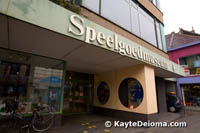 Mechelen is known for having the first international Carillon School, and being the home of the De Wit Tapestry Factory, which restores tapestries for castles and museums around the world. But its youngest world-class attraction is the Flanders Toy Museum (Speelgoedmuseum), which since opening in 1982, has grown from 7,800 square feet to over 32,000 square feet of space devoted to the display, preservation and interpretation of play things.
Mechelen is known for having the first international Carillon School, and being the home of the De Wit Tapestry Factory, which restores tapestries for castles and museums around the world. But its youngest world-class attraction is the Flanders Toy Museum (Speelgoedmuseum), which since opening in 1982, has grown from 7,800 square feet to over 32,000 square feet of space devoted to the display, preservation and interpretation of play things.
The museum is located in a rather drab converted four-story department store, whose showcase windows, although filled with toys, give no hint of the creativity displayed inside.
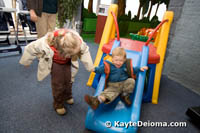 About 15,000 of the museum’s 20,000 toys are on display at any one time. You have to pass the gift shop and play area before you get to the exhibits, so if you’re visiting with kids, plan a few minutes of playing at the beginning and end of your visit to avert the frustration of not being able to play with the toys on display.
About 15,000 of the museum’s 20,000 toys are on display at any one time. You have to pass the gift shop and play area before you get to the exhibits, so if you’re visiting with kids, plan a few minutes of playing at the beginning and end of your visit to avert the frustration of not being able to play with the toys on display.
“Everything you see in everyday life you can see in toys” says Museum Director, ??. “We try to show the connections between the objects and society. Through the developments in toys, you can see the evolution of our culture.”
Most of the permanent exhibits are only tagged in Dutch, or Dutch and French, so it’s helpful to hire and English tour guide if you really want to understand the significance of what you are seeing. Guides are available by appointment for 25 euros for one to 25 people.
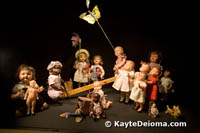 On the first floor, cases are filled with hand puppets, marionettes and dolls – fabric dolls, wooden dolls, porcelain dolls, and plastic dolls. Some display cases show the work of a particular manufacturer or country. Others show doll play groups set up at a picnic, on a sailing outing, in the kitchen, in a music shop and numerous other settings.
On the first floor, cases are filled with hand puppets, marionettes and dolls – fabric dolls, wooden dolls, porcelain dolls, and plastic dolls. Some display cases show the work of a particular manufacturer or country. Others show doll play groups set up at a picnic, on a sailing outing, in the kitchen, in a music shop and numerous other settings.
The exhibit on the evolution of the toy typewriter mimics the progress of the real thing, with over 50 examples in the museum’s collection.
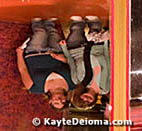 A full-size funfair mirror is your welcome to the mechanical Funfair exhibit, with miniature merry-go-rounds, Ferris wheels and other carnival attraction. You’ll also see the museum’s first acquisition, a duo of mechanical clowns from 1880 that do a balancing act.
A full-size funfair mirror is your welcome to the mechanical Funfair exhibit, with miniature merry-go-rounds, Ferris wheels and other carnival attraction. You’ll also see the museum’s first acquisition, a duo of mechanical clowns from 1880 that do a balancing act.
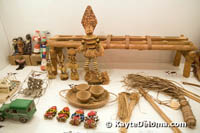 In a partnership with UNESCO, the museum exhibits toys made by children, folk artists and cooperatives in developing countries. This is one area where tags are also in English, but there’s not a lot of interpretation.
In a partnership with UNESCO, the museum exhibits toys made by children, folk artists and cooperatives in developing countries. This is one area where tags are also in English, but there’s not a lot of interpretation.
The most creative exhibit by far is the life-size walk-in model of Pieter Bruegel’s 16th century painting, Children’s Games. A poster of the 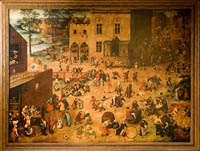 painting, depicting children playing 80 different games, is just outside the entrance. Many of the games illustrated, like leap frog or cartwheels, don’t require toys, and the space in the painting where these things are going on is empty in the room, waiting for groups of kids to fill the space. Examples of the playthings that are evident in the painting are
painting, depicting children playing 80 different games, is just outside the entrance. Many of the games illustrated, like leap frog or cartwheels, don’t require toys, and the space in the painting where these things are going on is empty in the room, waiting for groups of kids to fill the space. Examples of the playthings that are evident in the painting are 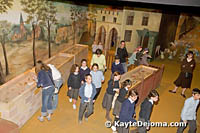 on display in glass cases at grade-school-child viewing level. Some of these include knuckle bones (the precursor to Jax), jump ropes, darts, marbles, hoops and tops.
on display in glass cases at grade-school-child viewing level. Some of these include knuckle bones (the precursor to Jax), jump ropes, darts, marbles, hoops and tops.
A few three dimensional characters from the painting are re-created climbing a fence near the display cases, and many more cutouts are placed in perspective playing into a 3D background. You can walk through Bruegel’s archways to see what’s beyond the painted space.
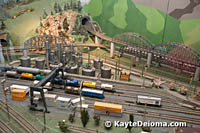 There is prominent display of model trains on the third floor. This spot was chosen because it has the best view of the real train station and railroad tracks out the window. The tiny town played a significant role in the history of the railroad in Europe. The first train on the continent went from Mechelen to Brussels in 1835.
There is prominent display of model trains on the third floor. This spot was chosen because it has the best view of the real train station and railroad tracks out the window. The tiny town played a significant role in the history of the railroad in Europe. The first train on the continent went from Mechelen to Brussels in 1835.
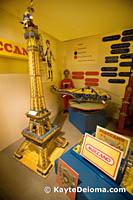 The history of the “teddy” bear, the evolution of board games from ancient Egypt to the present, wooden blocks with castle turrets and metal building sets from which you could construct the Eiffel Tower, are a few more fascinating exhibits from the permanent collection.
The history of the “teddy” bear, the evolution of board games from ancient Egypt to the present, wooden blocks with castle turrets and metal building sets from which you could construct the Eiffel Tower, are a few more fascinating exhibits from the permanent collection.
A large part of the third floor is given over to temporary exhibits. For the museum’s 25th anniversary, they created a striking display of the private childhood toy collections of famous Belgians, from actors and musicians to politicians and journalists. An interactive spotlight area was created for each category where you could stand behind a podium to give a press conference, like a politician, be a TV talk show host and see yourself on TV, or be onstage in a band.
For the 50th anniversary of LEGOs, in 2008, they are planning an extensive LEGO exhibit.
If you plan your visit to Mechelen on a Saturday, you can also pay a visit to the exhibit rooms of the DeWit Tapestry Factory (10:30 am) or hear a Carillon performance (11:30 am). English language city tours can be arranged through the Mechelen Tourism Office
Flanders Toy Museum (Speelgoedmuseum Mechelen)
Nekkerspoelstraat 21
2800 Mechelen
Belgium
Phone: (32) (0) 1555 70175
www.speelgoemuseum.be
Mechelen Tourist Office
Hallestraat 2-4-6
2800 Mechelen
Belgium
Phone: (32) (0) 7022 2800
www.inenuitmechelen.be
